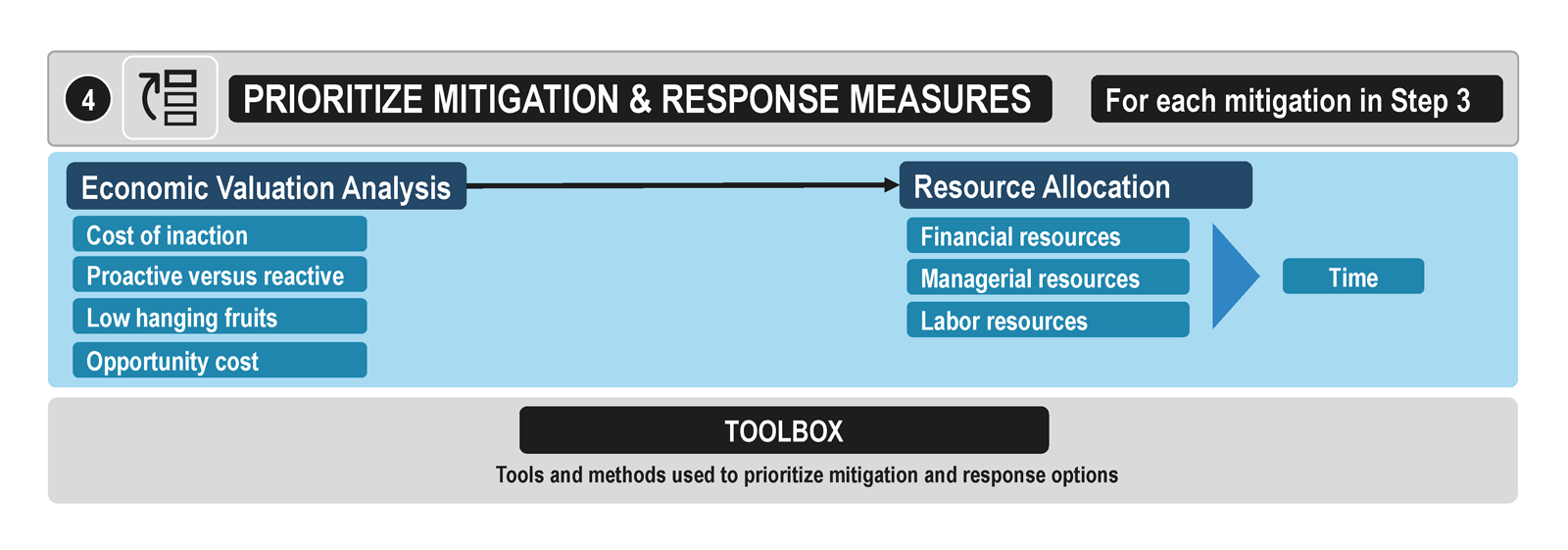Once mitigation and response measures have been elaborated (Step 3), each measure must be prioritized and the resources required for its implementation needs to be assessed, earmarked and mobilized (figure 20). When assigning an order of priority to the various response options and mitigation measures, it is important to distinguish between critical measures which could have dire consequences if left unaddressed, from those that are relevant but not essential. Their absence would not be detrimental to the port and its ability to cope and recover from the disruption.
Figure 20: Step 4 – Prioritization of response and mitigation measures and resource allocation

The investments required for port infrastructure and superstructures are determined according to risks which can be ranked and prioritized. Cost-effectiveness analysis, stakeholder analysis and multi-criteria analysis are among a range of methods that can be used to conduct an economic valuation. Setting priorities or establishing a sequence of measures should be based on criteria, such as past experiences or current strategies being implemented by similar ports, as well as take into consideration other factors, such as affordability and the technical feasibility. Measures can be evaluated using a cost-benefit analysis to weigh the potential benefits of a response option or mitigation measure against its expected costs. Prioritization involves four fundamental issues:
- Cost of inaction. The default position concerning risk, and accompanying mitigation and response measures, could be to not take any tangible actions, particularly if the risk is not clearly identified, is of low probability, and requires expensive response and mitigation action. Inaction can appear to be an attractive proposition, and a conclusion may be reached that no resource allocation is required. This could also be related to the expectation that the costs associated with a disruptive event will, in part, be assumed by a third party, such as a terminal operator (e.g. it will need to clear any liability it may have), an insurer (with respect to coverage), or government entities (in the case of disaster relief).
- Proactive versus reactive. Each hazard risk can be mitigated, and its impacts alleviated proactively and reactively. Proactive measures (pre-event that promote preparedness and prevention) tend to be more expensive than reactive measures (post-event and focus on mitigating immediate impacts and concerns). Since most hazard events cannot be predicted accurately (unreliable risk assessment), reactive measures can be perceived to make more sense from a cost/benefit perspective.
- “Low hanging fruit”. This usually involves a mitigation and response initiative that stands out from a cost/benefit perspective rather than more complex and expensive measures. In recent years, cybersecurity issues have emerged as one of the most salient risks to ports; this issue can be proactively mitigated, and its impact alleviated with a pre-event implementation of up-to-date software and staff training to avoid common threats, e.g. “fishing” emails containing malware. Paradoxically, a reactive post-event approach to cybersecurity can be much more costly.
- Opportunity cost. The time and resources allocated to risk mitigation (identification, potential impact assessment, and management), preparedness (pre-event measures), and response (post-event action and measures) is usually at the expense of other priorities and considerations. For example, the resources earmarked to increase port resilience against potential hazards could have been spent on expanding infrastructure, buying equipment, improving port marketing, or paying off a debt.
Each response and mitigation measure requires allocating often scarce resources, or constrained by other competing demands on the budget:
- Financial resources need to be earmarked to implement response and mitigation measures that have been prioritized and elaborated. Where will the funding come from? Can the port revenues and financial resources sustain the expenditure? Does it require contracting debt, such as issuing bonds? Are there grants available from national or international agencies?
- Managerial resources will be required to provide overall guidance and oversight when elaborating, implementing, monitoring, reporting and reviewing the effectiveness of response and mitigation measures deployed.
- Labor resources, including a skilled workforce will be required to elaborate, implement, monitor, report and review the effectiveness of any response and mitigation measures that may have been deployed. For smaller ports, particularly in developing countries, know-how, technical knowledge, expertise and technology are particularly important as these are less ubiquitous.
